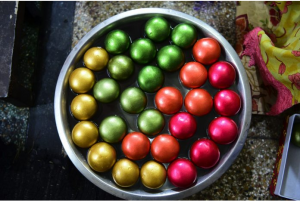ForumIAS announcing GS Foundation Program for UPSC CSE 2025-26 from 19 April. Click Here for more information.
ForumIAS Answer Writing Focus Group (AWFG) for Mains 2024 commencing from 24th June 2024. The Entrance Test for the program will be held on 28th April 2024 at 9 AM. To know more about the program visit: https://forumias.com/blog/awfg2024
Source-This post on Gulaal Gota: Jaipur’s traditional method for celebrating the Holi festival is based on the article “Explained: On Holi, a look at Jaipur’s traditional celebrations with ‘Gulaal Gota’” published in “The Indian Express” on 22nd March 2024.
Why in the News?
As Holi approaches on March 25th this year, Jaipur, Rajasthan will continue its age-old tradition. The celebration involves “Gulaal Gota,” a unique practice dating back around 400 years, which includes throwing colors.
What is a Gulaal Gota?

A Gulaal Gota is a small ball made of lac, filled with dry gulaal, weighing about 20 grams. People throw these balls at each other during Holi, and they break upon impact.
Method of Making
1. Boiling of Lac in water– Local artisans explain that crafting Gulaal Gotas begins with boiling lac in water to soften it.
2. Mixing of colours– Once the lac is shaped, color is mixed in, starting with red, yellow, and green, which can be combined to create additional colors.
3. Carved in to spherical shape– Once processed, artisans heat the lac and use a blower called “phunkni” to blow it into spherical shapes. Afterward, the balls are filled with gulaal and sealed with lac.
Note– Lac is a resinous substance produced by specific insects and is also utilized in bangle making.
Where does the raw material for Gulaal Gota come from?
1. Lac is sourced from Chhattisgarh and Jharkhand, where the female scale insect serves as one of the primary sources.
2. According to the Chhattisgarh State Skill Development Authority’s website, approximately 300,000 insects are killed to produce 1 kg of lac resin. The lac insects also provide resin, lac dye, and lac wax.
How did Gulaal Gotas become a tradition in Jaipur?
1. Muslim lac artisans, known as Manihaars, exclusively craft Gulaal Gotas in Jaipur.
2. The ancestors of the Manihaars were shepherds and horse traders from Afghanistan. They settled in Bagru, near Jaipur, and learned lac-making from Hindu lac makers, known as Lakhere.
3. Jaipur, founded in 1727 by Sawai Jai Singh II, a patron of the arts, has a lane in Tripoliya Bazaar named “Manihaaron ka Raasta” dedicated to the Manihaar community. This lane remains a hub for selling lac bangles, jewelry, and Gulaal Gota to this day.
UPSC Syllabus- History and Art & Culture




